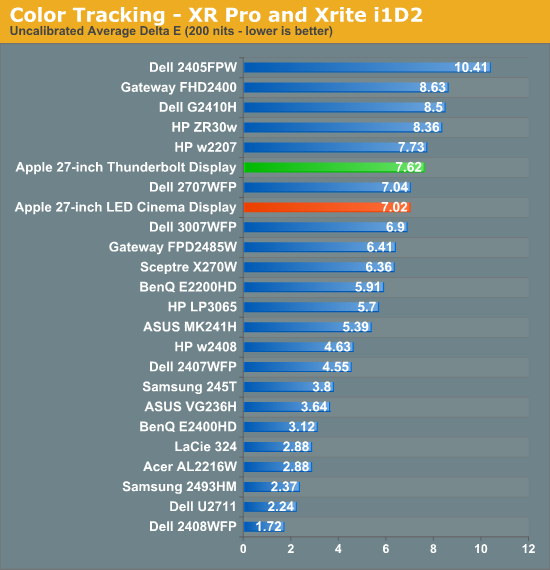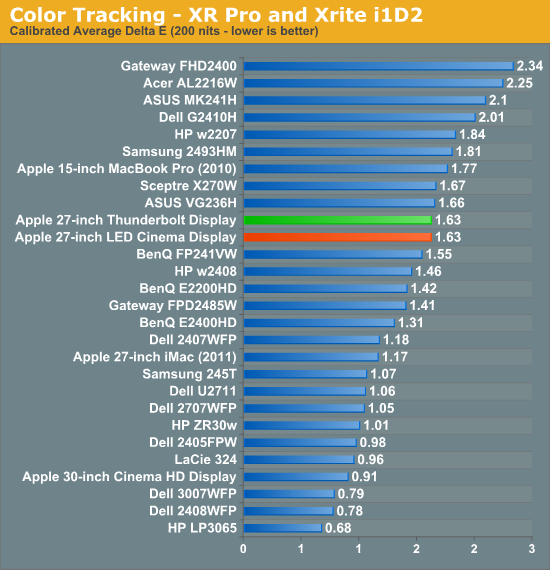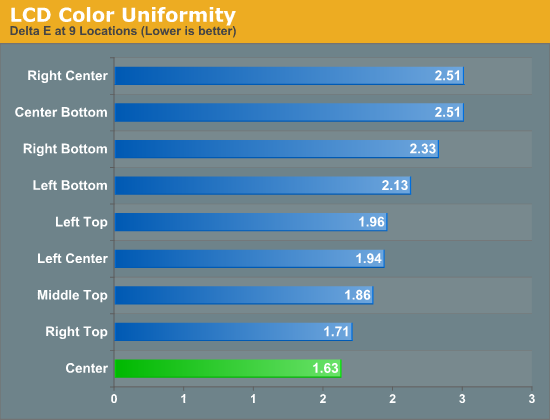The Apple Thunderbolt Display Review
by Anand Lal Shimpi on September 23, 2011 2:56 AM EST- Posted in
- Displays
- Mac
- Apple
- Thunderbolt
- Thunderbolt Display
Display Testing
With all of the extra connectivity there is to test with the Thunderbolt Display we can't forget the actual panel testing. Thankfully this part is pretty simple, the display characteristics are near identical to the 27-inch LED Cinema Display we reviewed last year.
Color Quality
We report two main quality metrics in our display reviews: color accuracy (Delta-E) and color gamut. Color gamut refers to the range of colors the display is able to represent with respect to some color space. In this case, our reference is the AdobeRGB 1998 color space, which is larger than the sRGB color space. So our percentages are reported with respect to this number, and larger is generally better.
Color accuracy (Delta E) refers to the display’s ability to display the correct color requested by the GPU and OS. The difference between the color represented by the display, and the color requested by the GPU is our Delta-E, and lower is better here. In practice, a Delta E under 1.0 is perfect - the chromatic sensitivity of the human eye is not great enough to distinguish a difference. Moving up, a Delta E of 2.0 or less is generally considered fit for use in a professional imaging environment - it isn’t perfect, but it’s hard to gauge the difference. Finally, Delta E of 4.0 and above is considered visible with the human eye. Of course, the big consideration here is frame of reference; unless you have another monitor or some print samples (color checker card) to compare your display with, you probably won’t notice. That is, until you print or view media on another monitor. Then the difference will no doubt be apparent.
As I mentioned in our earlier reviews, we’ve updated our display test bench. We’ve deprecated the Monaco Optix XR Pro colorimeter in favor of an Xrite i1D2 since there are no longer up-to-date drivers for modern platforms.
For these tests, we calibrate the display and try to obtain the best Delta-E we can get at 200 nits of brightness for normal use. We target 6500K and a gamma of 2.2, but sometimes the best performance lies at native temperature and another gamma, so we try to find what the absolute best performance could be. We also take an uncalibrated measurement to show performance out of the box using either the manufacturer supplied color profile, or a generic one with no LUT data. For all of these, dynamic contrast is disabled.

Uncalibrated performance remains fairly similar to last year's LED Cinema Display, however once calibrated the Thunderbolt Display is spot on with its predecessor:

As we mentioned earlier, a sub 2.0 delta E is good enough for professional use. Although not perfect the Thunderbolt Display falls within that range for sure.


We measured slightly lower color gamut on the Thunderbolt Display than the original LED Cinema Display, however the result was much closer to the 2011 27-inch iMac. I couldn't visibly tell any differences and Apple indicates that color gamut shouldn't have changed, so it's quite possible that the differences here are due to our colorimeter and not the panel.
Color Uniformity
Now for color consistency, we take our best calibration profile from the very center at 200 nits and test color accuracy at 9 different places around the LCD display in an evenly distributed grid. We’ve shown before that calibration is localized across the display, partly due to the brightness not being uniform, partly due to the discrete nature of the display itself.

The Thunderbolt Display was fairly uniform across its surface, something we noticed in reviewing the 27-inch LED Cinema Display last year. Uniformity is actually better on this panel than the one we reviewed last year, although in both cases I couldn't really tell any differences.
Peak brightness appears down slightly, but so are the black levels which result in a slightly better contrast ratio. Apple is also calibrating these things at the factory now so white points are now set at around 6300K vs. 7100K on the original 27-inch LED Cinema Display.










275 Comments
View All Comments
GotThumbs - Friday, September 23, 2011 - link
It's a hardware review and the specs are in the article. This is not intended to be an MTV production to keep ADD kids entertained. Either you find the content interesting or now. If not, change the channel.Iketh - Friday, September 23, 2011 - link
OSDs would have only distracted me... i was listening to him like we were having a 1 on 1... overlays would have fucked that upxodius80 - Friday, September 23, 2011 - link
i must say is not only entertaining to see the video but its so much easier to understand, notes on what ive seen u might need:Fisrt a green screen so u can put your logo anywhere so you dont compromise your publicity on depending hardware reviews, your persona blocked your logo, and thats not good for bussiness, all the time it was reading nandtech, def not good =), a little more post production if u got the time, even tho it was perfect , heres an idea, like the time u where explaining the motherboard inside the monitor, it should have disolved to the picture into a main whole frame, while your voice in off, then disolve back to you. things like that make videos more intresting.
sorry for my english, just helping you out since ive studied video here in my country, nice job man! ohh yeah and cool mic haha.
fynamo - Friday, September 23, 2011 - link
Just for everyone's reference, these displays do work with Windows. I've been using one for a while and love it. The only issue I had was when trying to adjust the brightness. You have to do some weird tweaks with AppleControlPanel.exe but I was eventually able to make it work.KLC - Friday, September 23, 2011 - link
Interesting hardware information, but why doesn't anyone talk about the stupid name? What's a thunderbolt? I know lightning bolts and I know thunder claps. Who made up this name Google Translator?jecs - Friday, September 23, 2011 - link
The technology is from Intel and I am not sure if the name itself is Intel or an Apple idea based on the Intel name. This is the first implementation and has a lot more potential but depends on how it will be adopted by the industry.Dug - Friday, September 23, 2011 - link
I really enjoyed it too. This gives a far more personal touch to the review and the visuals give a clear example of what you are talking about.I've always liked seeing things in action because stagnant pictures don't tell the whole story.
SickBeast - Friday, September 23, 2011 - link
How much does the thing cost?This website needs to stop functioning as marketing PR and should get back to its roots as a hardware review website. The price of this display should be boldly listed both in the introduction and the conclusion of the article.
The review of Windows Vista on this website really opened my eyes to the fact that AnandTech has gone in a completely new direction. It's too bad.
Anand, please revert to your role as a journalist and stop acting as a puppet for these large corporations.
jecs - Friday, September 23, 2011 - link
$1000 formally $999But tell me what product, a decent one deserving a good review, does not comes with a brand name and marketing?
Your whole observation is very emotional.
Anand, please keep with the good work! not because I ask for it.
mharding - Friday, September 23, 2011 - link
The Thunderbolt Display's motherboard is full of controllers driving all of the rear facing IO ports. On the front we actually see the very first non-SFF Eagle Ridge IC. Although the MacBook Air uses Eagle Ridge, it uses the SFF version in a cheaper package. I'm sure what determines whether or not Apple uses the flip-chip packaged version.Thanks for the review - I much prefer reading quickly than watching a video slowly.